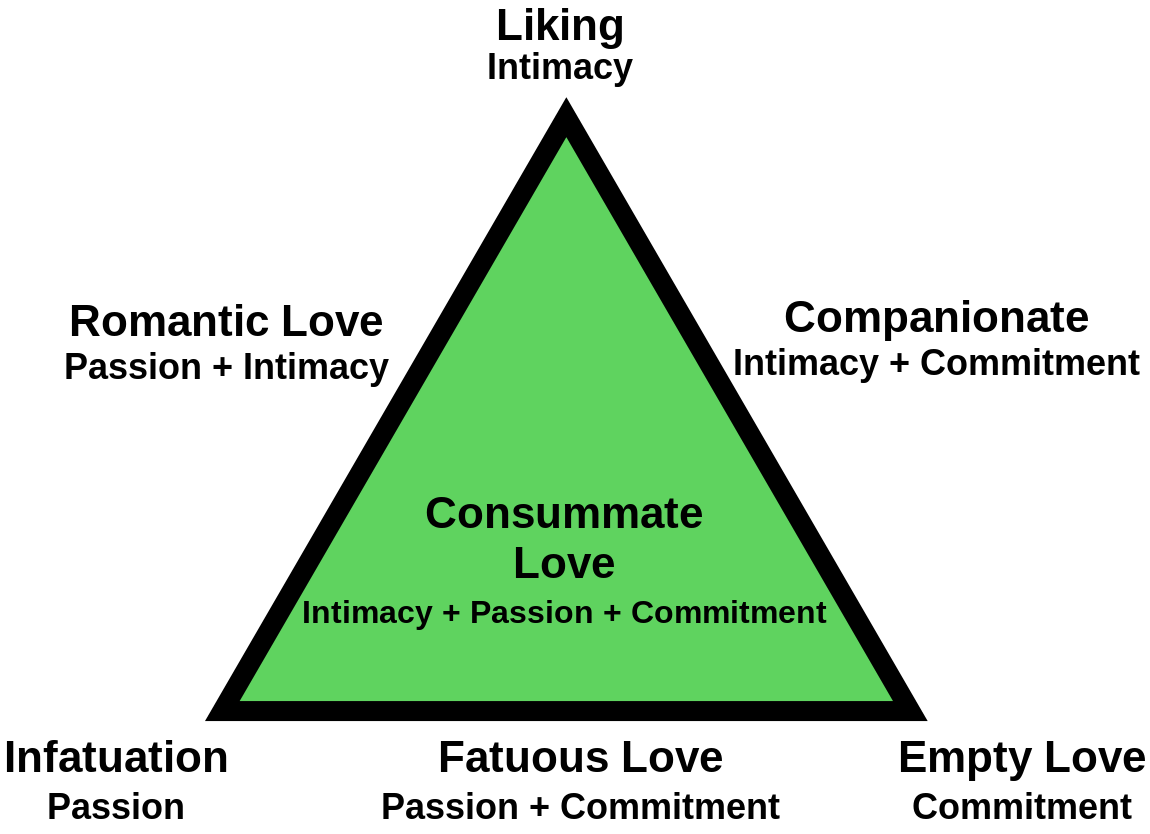My last blog mentioned a quiz that people could take in order to see where they lie along Dr. Robert Sternberg’s “Triangle of Love.” This conceptualization of love may not capture certain key aspects of what some people consider to be love in their own relationships. In fact, no definition or even lengthy description could ever do justice to such a complex and, in many ways, abstract phenomenon.

However, the Triangular Theory of Love does present a very practical and useful way of looking at one’s current relationship or perhaps one’s maladaptive beliefs about relationships. As illustrated in the picture below, the three points of the triangle are:
- Passion – the sexual attraction, “chemistry” or intense–almost obsessive–physiological, psychological and emotional reactions one feels in relation to someone else
- Intimacy – a sense of deep emotional attachment, bonding or connectedness with the other person
- Commitment – first, the decision first to remain with someone long enough to establish a relationship and then later the determination to stay with that person in the long-run
Interested readers can learn more here about the various kinds of love created by different combinations of the three points of the triangle. The main point I discuss with my patients and students is that they need to be realistic about their relationships. One way to do that is to think of the triangle as being about 1/2 to 3/4 full–whereas it would be completely full with ideal “Consummate Love,” which may exist at the start of a relationship or for brief periods throughout. But too many people have a “Disneyesque” fantasy image of love that would correspond to the triangle being full all of the time.
Conversely, it is more adaptive to realize that most relationships go through periods during which there is less sexual activity, less friendly or enjoyable time spent together, or even doubts about whether one or both parties want to remain together. If one normalizes such developments, there should be less distress, panic or irrational reactions, and reduced risk of saying or doing things that cannot be taken back–such as making an impulsive decision to leave what is, in fact, a healthy and rewarding relationship.
- A ‘zombie’ virus is raging among raccoons. What to know
- Ultra-processed food tied to higher risk of early death, study finds. What to avoid
- N.S. couple felt they won ‘doctor lottery’ after years on wait-list. Now they’re back on it
- Panera to remove ‘Charged Sips’ drink from Canada amid wrongful death lawsuits
Returning to “the triangle is half-full” approach, the triangle tilts in different directions over time, meaning that certain points will be more prominent at various times throughout the relationship. For instance, most people will agree that, when they first fall in love with someone, the triangle is tilted heavily toward the Passion corner; researchers have identified the neuro-chemical changes the brain goes through in this stage: mainly involving dopamine, serotonin and norepinephrine. This is why many media outlets proclaimed that love supposedly dies after 18 to 24 months, as that is when the brain apparently reverts to its normal state.
Fortunately, other affected neurotransmitters and hormones remain active afterward, along with the myriad cognitive, emotional and psychological processes involved in love both during and after the initial spike in the Passion stage. The key point is that people need to be realistic and realize that, for instance, there will most likely be periods within the relationship that they feel less (sexually) attracted to their partner. They should also not expect to have as much sex, say, five years later as they were the first few months of dating–especially if they now have children, they have more work commitments or other major changes have occurred over the years.
Unfortunately, most people can also expect to go through rough stretches when the Intimacy corner seems (nearly) empty. If this happens when there are few or no reserves in the Passion corner, one is stuck in “Empty Love.”
It is usually not adaptive to remain in a loveless relationship, although sometimes circumstances do not enable one to leave a partner–or at least that is how it seems to the person or couple. One of my previous blogs explained some of the reasons people feel they cannot terminate a doomed relationship, while another blog examined some of the factors that can make such relationships so noxious.
However, there is a huge difference between being stuck in an unhealthy relationship that cannot be saved versus temporarily experiencing apathy, boredom, pessimism, hurt, resentment or other negative mood states while committed to someone who is, in fact, a pretty good partner. Put another way, making worthwhile relationships last often requires the couple to work on developing and strengthening the Commitment corner of the triangle, while adopting a mature and realistic outlook on relationships–which can include recognizing that each partner may have different views on what love is and how they should express it.
In line with the theme of this article, another mature and adaptive perspective on relationships is that, when you are honest with yourself and your partner, you can identify some of the issues that may have been draining the love from the triangle and/or tilting it away from where you would like it to be. Most importantly, working together, employing effective communication techniques and perhaps coming up with creative ways to bring back the “spark” or sense of companionship can help you refill and reorient the triangle to a more mutually satisfying position–assuming the relationship is indeed worth fixing.
Upcoming blogs will explore how to determine whether a relationship is indeed worth saving and how to avoid being trapped in a barren or toxic triangle.







Comments